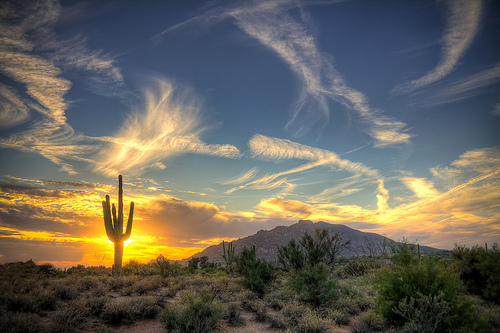It’s a wonderful thing that the Pope’s new ride will be a plug-in hybrid, but vroom vroom doesn’t sound as sexy as it used to. Not when gas is $4 a gallon and the average car causes 600 pounds of air pollution every year. Obama’s pledge to up fuel-efficiency standards to an average 56.2 miles per gallon by 2025 is all well and good. But in the meantime, a troublesome economy is driving people to drive less.
AAA’s Fourth of July holiday report cited a decline in car travel and a shift towards alternative modes of transportation. Biking and low-cost interstate bus travel are on the rise. Might this be the start of a new era of footprint-sensitive vacationing? (Let’s think positive and say, “Yes.”)
So, where should you take your next car-free getaway?
These six cities may not boast mass transit systems like New York’s, but they do have what it takes to make discovering their best features an easy, fun, and affordable experience without a car.
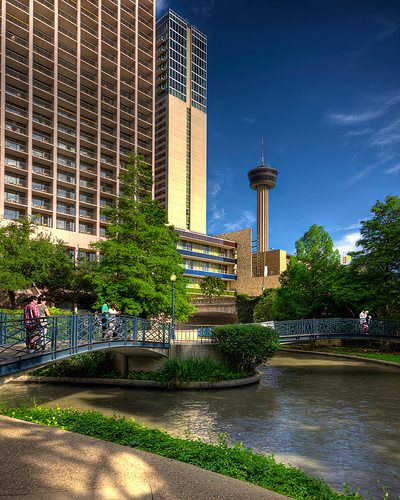 Photo: Brandon WattsSan Antonio, Texas
Photo: Brandon WattsSan Antonio, Texas
Known for its historic preservation, San Antonio is making its future about conservation with a freshly launched B-cycle bikeshare program — first in the state, eighth in the nation — and soon, the largest urban ecosystem renovation in the country. Along the 12-mile Mission Trail, visitors can see 17th-century Spanish colonial missions (including the Alamo) from their B-cycles ($10/day) or take in downtown sights like La Villita Historical Arts Village by trolley ($4/day or $1.10/one way). Other transportation activities include battery-powered Segways and the Rio Taxi ($5/one way or $10/day), making 39 stops along the scenic San Antonio River near cultural and foodie attractions such as new-to-the-table Culinary Institute of America, Pearl Brewery, and Museo Alameda. Check out the tourism board’s useful online bike guide to learn about the city’s most interesting leisure rides.
How to get there: A 10-15 minute taxi ride from San Antonio International Airport into downtown just eight miles away is the best way to go.
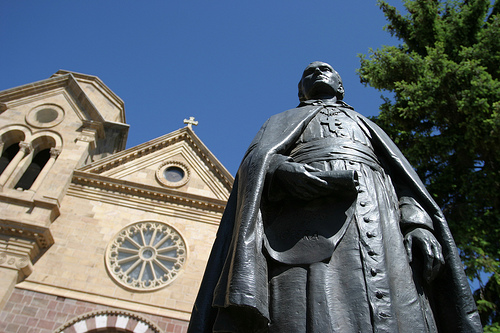 Photo: John LobelSanta Fe, New Mexico
Photo: John LobelSanta Fe, New Mexico
The oldest capital in the country knows a bit about sustainability. Santa Fe’s pride in its 401-year history is ever-present, from its distinctive Spanish Pueblo Revival architecture and well-preserved buildings to its thriving cultural arts scene. Its laudable public transit offerings include a free downtown shuttle and free bike storage on buses and trains. Located in the historic downtown area, Mellow Velo rents three-speed City Cruisers for $20 a day (with a basket, bell, and lock) and is a smart place to pick up local tips and maps for riding on the half a dozen safe bike trails and beyond. The New Mexico Rail Runner Express ($7/one way, $8/day), Santa Fe Trails, the city’s bus system ($2/day), and self-guided gallery walks on Canyon Road are other great options for tourists to see more while emitting less. One thing is certain while visiting this UNESCO Creative City, whether you choose to explore the Georgia O’Keeffe Museum, shop the Railway’s farmers markets, or hike the Sangre de Cristo Mountains — you will find yourself feeling fitter outside the driver’s seat than you ever did in it.
How to get there: From the Albuquerque International Sunport Airport, have the Sandia Shuttle Express ($27 one way or $47 roundtrip) drop you off at your hotel in Santa Fe in an hour. If you are flying into the Santa Fe Municipal Airport from Dallas or Los Angeles, then the Roadrunner Shuttle will take you into the center of town in 20 minutes.
 Photo: nycboneBaltimore, Maryland
Photo: nycboneBaltimore, Maryland
With our nation’s capital now sporting shiny new shareable bikes just down the road, it’s no wonder Baltimore has gotten its own two-wheel deal, albeit on a smaller scale, with 250 bikes at 25 stations. While residents wait for an official launch date, there are plenty of other ways for tourists to navigate the city’s best crab cakes. The Charm City Circulator’s free, eco-friendly shuttles service all the interesting and quirky parts of town, including Inner Harbor, historic Fell’s Point, and Federal Hill. With a $10 day pass and a solid stomach, you can ride Ed Kane’s Water Taxis to 30 different hot spots like the National Aquarium, Fort McHenry, Maryland Science Center — home to America’s first all-electric, car-sharing Altcar — and Rusty Scupper, known for its views and fresh seafood. To get your heart rate up, dissect the city with a Light Street Cycle bike ($25/day) and at lunchtime, reward exercise with picnic fixings at Baltimore Farmers’ Market & Bazaar or settle into Gertrude’s for a farm-to-fork lunch and live jazz at the Baltimore Museum of Art.
How to get there: From the BWI Airport, take the Light Trail to Baltimore for $1.60.
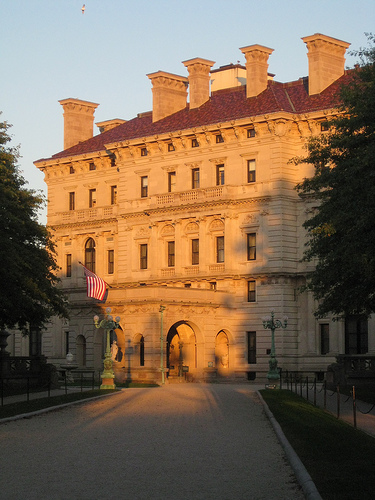 Photo: Jenna Rose Robbins
Photo: Jenna Rose RobbinsNewport, Rhode Island
Gilded Age mansions, dreamy surfer beaches, and charming cobblestone streets should be enjoyed while strolling or cycling, with a slight sea breeze going and the sun warming your shoulder blades. There are few travel destinations that can truly be appreciated by driving through them, and that especially goes for Newport. With a Trek bike ($7/hour, $35/day) from Ten Speed Spokes, pedal the beautiful 10-mile Ocean Drive and around paved state park trails in Fort Adams before heading back into downtown, studded with bars, boutiques, and historic B&B’s. Refuel at Tallulah on Thames, a delicious, organic, and inventive new restaurant. For an adventurous day excursion, bring your bike aboard the ferry ($15.95/round-trip plus a $6.20 bike fee) and explore pristine Block Island. If you like island hopping, consider spending a night on your very own private (and ecologically sound) Rose Island in the middle of Narragansett Bay. For more information on public transportation options, visit gonewport.com.
How to get there: From T.F. Green Airport, 30 minutes away, take a Cozy Cab ($25/one way) or two RIPTA buses ($2/fare). Take a Peter Pan Bus from Boston’s Logan International Airport.
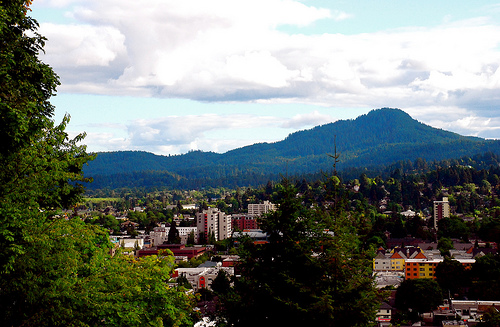 Photo: Don HankinsEugene, Oregon
Photo: Don HankinsEugene, Oregon
A bike is no foreign object to the Beaver State. Both Portland and Eugene are fine examples of how bike culture is going strong in the Pacific Northwest. Visitors can slip into cycling as a way of life in Eugene, where 30 miles of off-street paths, 89 miles of on-street bike lanes, five bike and pedestrian-friendly bridges, bike rack-equipped buses ($1.50/fare), and a 12-mile path along the Willamette River add to the fun and ease of discovering the town’s favorite haunts. Whether you take advantage of Eugene’s solid bike path infrastructure [PDF] or not, the eco-minded community encourages green living in other ways, with the Lane County Farmers Market downtown, a Lively Organic Farm Stay, a new all-local, modern Italian restaurant, Osteria Sfizio, and clever Pedicab travel packages. The Saturday Market showcases Oregon-based craft and food vendors while the Valley River Inn just opened a bakery to better accommodate bike commuters. For more information on car-free exploration, visit TravelOregon.com.
How to get there: There are 15 Eugene area hotels that offer transportation to and from the airport, 20 minutes away from the center of town. If you’ve explored the state further afield without a car, the Amtrak Cascades train will take you into Eugene, and allows bikes on board for a nominal $5 fee.
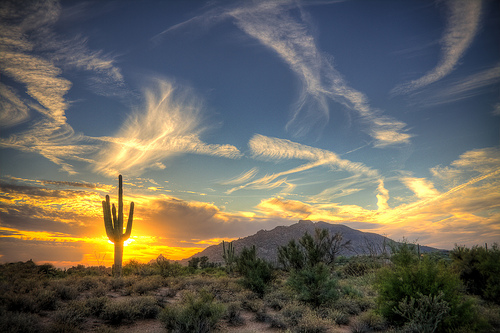 Photo: Jason CorneveauxScottsdale, Arizona
Photo: Jason CorneveauxScottsdale, Arizona
You can add car-free to this city’s list of celebrated C’s — citrus, cattle, cotton, copper, and climate. Out here in the Sonoran Desert, red rocks, richly preserved history, and fierce Wild West beauty inspire tourists to keep their carbon footprint light. For those who’ve packed a ready sense of adventure, Scottsdale has successfully figured out how to facilitate an effortless ecological vacation. Guests staying at mid-century landmark Hotel Valley Ho will have access to classic cruisers ($15/hour, $50/day, includes helmet, bike lock, basket, water) and a great location; the 25-mile Greenbelt, free downtown trolley stop, art galleries, newly erected Soleri Bridge, Scottsdale Museum of Contemporary Art, and much more are all within a two-mile radius. After biking (or taking a Clean Air Cab) to climb Camelback Mountain’s humps — less than five miles from Hotel Valley Ho –return to the heart of Scottsdale for lunch at FnB, Petite Maison, or Arcadia Farms, some of the city’s star restaurants offering sustainable fare and state-sourced wines. For travelers eyeing the saguaro cactus-studded horizon, consider a revelatory day trip with professional outfitters My Arizona Guide or 360 Adventures.
How to get there: From Phoenix Sky Harbor Airport, take a taxi three miles along a scenic road to Scottsdale. Old Town is just 15 minutes away. Bike Emporium is a more budget-friendly bike rental option at $15/hour or $35/day.
Note: Before boarding a plane to reach any of these destinations, consult Brighter Planet’s latest study on the world’s greenest airlines (Continental and United are among the cleanest) and follow this guide to eco-friendly flying. For more tips, read Grist’s How to green your vacation.

